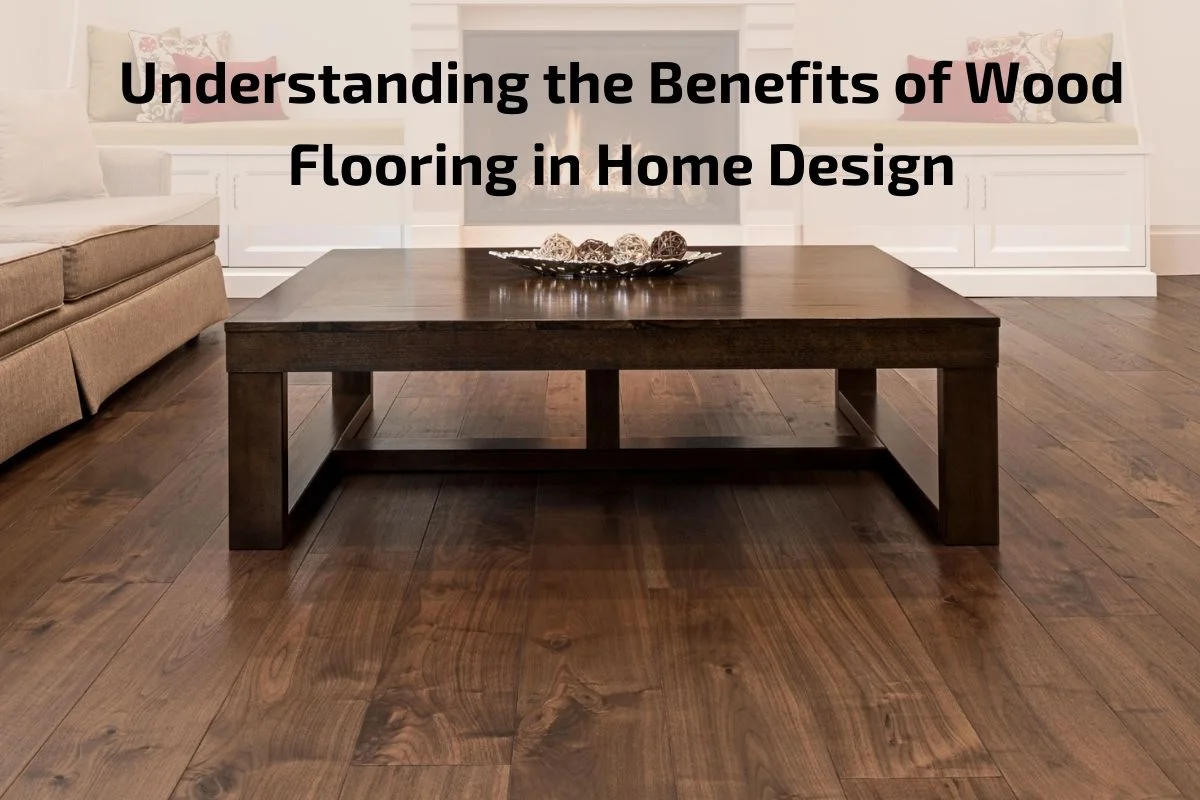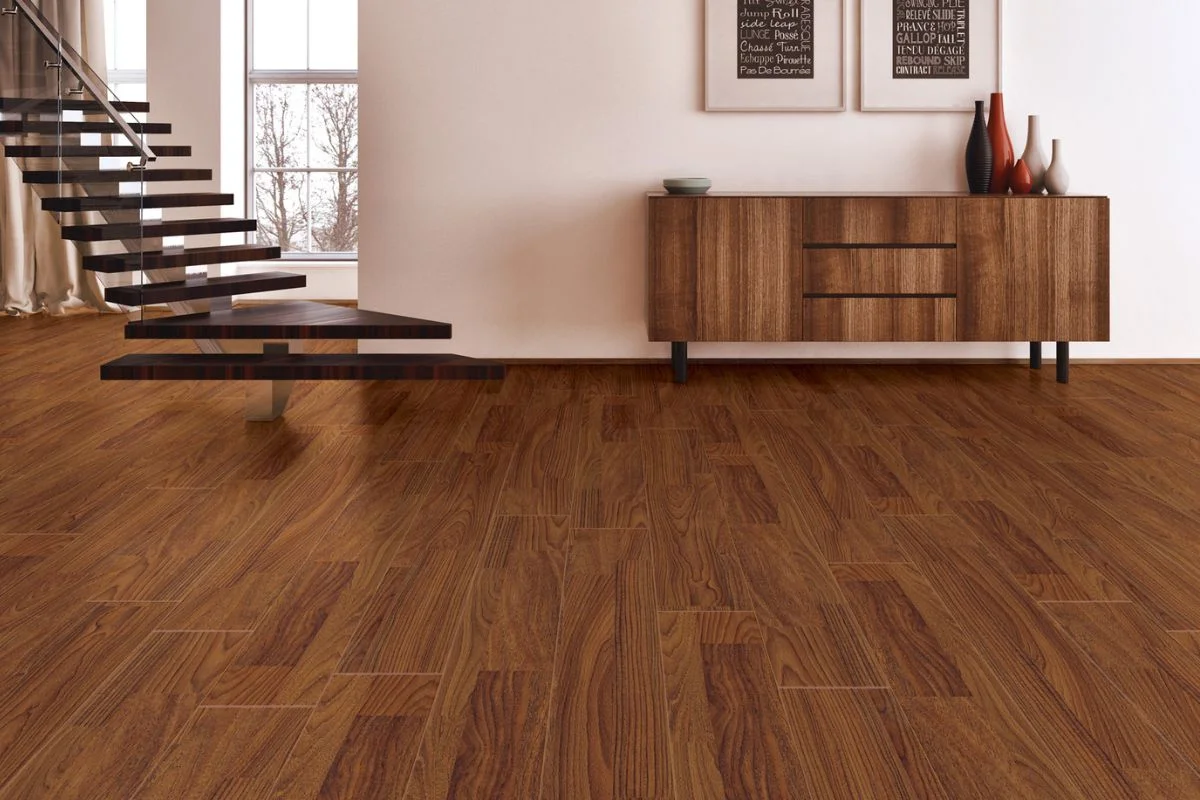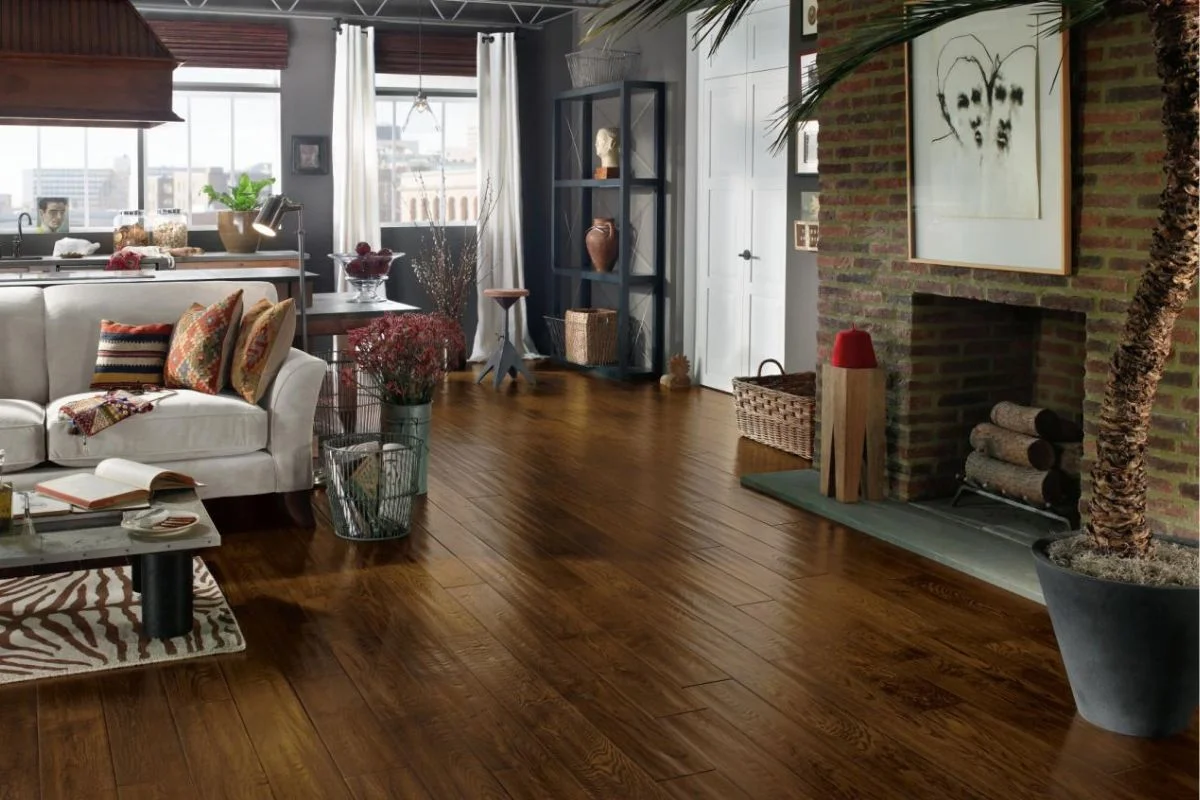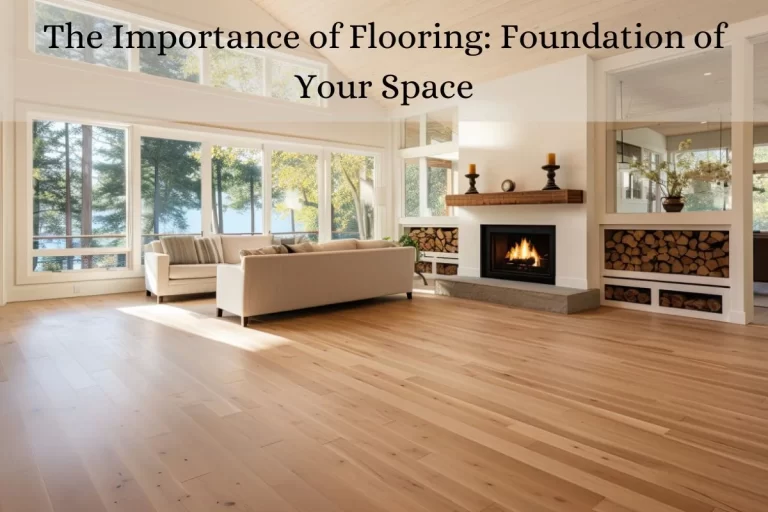Wood flooring stands as a timeless symbol of elegance and sophistication in home design. Its natural beauty, durability, and versatility have made it a staple choice for homeowners seeking to elevate the aesthetic appeal and functionality of their living spaces. From traditional hardwoods to modern engineered options, wood flooring offers a wealth of benefits that transcend trends and endure through generations.
In this exploration, we delve into the myriad advantages of wood flooring in home design. From its ability to enhance the ambiance of any room to its durability and sustainability, wood flooring emerges as a quintessential element that adds warmth, character, and value to residential interiors.
Brief overview of wood flooring
Wood flooring is a classic and versatile option for enhancing the beauty and functionality of residential and commercial spaces. It consists of natural wood planks or engineered wood products that are installed as durable and stylish flooring surfaces. Wood flooring is prized for its timeless appeal, warmth, and ability to complement a wide range of interior design styles.
Traditional hardwood flooring is crafted from solid wood planks, typically harvested from hardwood trees such as oak, maple, cherry, or walnut. These planks are milled to precise dimensions and can be finished in various stains and sealants to enhance their natural color and grain patterns.
Engineered wood flooring, on the other hand, is constructed from layers of plywood or fiberboard with a top layer of real wood veneer. This construction allows for greater stability and resistance to moisture, making it suitable for installation in areas where solid hardwood may not be ideal, such as basements or bathrooms.
Wood flooring offers numerous benefits, including durability, longevity, and the ability to increase the value of a property. It provides a warm and inviting atmosphere to any room while offering easy maintenance and repair options.
Overall, wood flooring remains a popular choice among homeowners and designers alike, offering timeless elegance and enduring appeal that can transform any space into a showcase of natural beauty and sophistication.
Importance of wood flooring in home design
Wood flooring holds significant importance in home design for several compelling reasons, making it a preferred choice for homeowners and designers alike:
Timeless Elegance: Wood flooring exudes timeless elegance and sophistication, enhancing the aesthetic appeal of any room. Its natural beauty and warmth create a welcoming atmosphere that complements a wide range of interior design styles, from traditional to contemporary.
Versatility: Wood flooring comes in various species, colors, finishes, and plank sizes, offering versatile options to suit diverse design preferences and architectural styles. Whether you prefer the classic charm of oak or the modern allure of maple, wood flooring provides endless possibilities for customization and personalization.
Durability and Longevity: Wood flooring is renowned for its durability and longevity, standing the test of time in high-traffic areas and busy households. With proper care and maintenance, hardwood floors can last for generations, making them a sound investment in the long-term value of a home.
Value Enhancement: Wood flooring adds significant value to a home, increasing its resale value and market appeal. Potential buyers are often drawn to homes with hardwood floors, recognizing them as a premium feature that elevates the overall quality and desirability of the property.
Natural Beauty: One of the most appealing aspects of wood flooring is its inherent beauty and character. Each plank tells a unique story through its grain patterns, knots, and variations in color and texture, adding richness and depth to the visual landscape of a room.
Warmth and Comfort: Wood flooring provides a cozy and comfortable underfoot feel, especially in colder climates. Unlike tile or stone floors, which can feel cold and unforgiving, wood flooring offers a natural warmth and insulation that enhances comfort and livability.
Easy Maintenance: Wood flooring is relatively easy to maintain and clean compared to other flooring materials. Routine sweeping, vacuuming, and occasional mopping are typically all that’s needed to keep hardwood floors looking beautiful and pristine for years to come.
Eco-Friendly Choice: Many wood flooring products are sourced from sustainably managed forests, making them an eco-friendly choice for environmentally conscious homeowners. Additionally, wood flooring can be recycled and repurposed at the end of its lifecycle, minimizing environmental impact.
Benefits of Wood Flooring
Wood flooring offers a multitude of benefits that contribute to its popularity and enduring appeal in home design. Here are some key advantages of choosing wood flooring for your home:
Timeless Beauty: Wood flooring exudes natural warmth and beauty, creating an inviting and elegant ambiance in any room. Its rich grain patterns, textures, and colors add character and charm to interior spaces, enhancing the overall aesthetic appeal of the home.
Durability and Longevity: Hardwood floors are renowned for their durability and longevity. When properly maintained, wood flooring can withstand heavy foot traffic, resist scratches and dents, and maintain its beauty for decades, making it a wise investment for homeowners.
Versatility in Design: Wood flooring comes in a variety of species, finishes, and plank sizes, offering endless design possibilities to suit diverse aesthetic preferences and architectural styles. Whether you prefer the classic warmth of oak or the contemporary appeal of maple, there’s a wood flooring option to complement any interior design scheme.
Increased Property Value: Wood flooring enhances the resale value and marketability of a home. Potential buyers are often willing to pay a premium for homes with hardwood floors, recognizing them as a desirable feature that adds sophistication and elegance to the living space.
Easy Maintenance: Wood flooring is relatively easy to maintain compared to other flooring materials. Routine sweeping, vacuuming, and occasional mopping are typically all that’s needed to keep hardwood floors looking clean and beautiful. Additionally, wood flooring can be refinished to restore its original luster and beauty.
Improved Indoor Air Quality: Unlike carpets, which can trap dust, allergens, and pet dander, wood flooring promotes better indoor air quality by minimizing the accumulation of allergens and pollutants. This makes wood flooring an ideal choice for individuals with allergies or respiratory sensitivities.
Eco-Friendly Option: Many wood flooring products are sourced from sustainably managed forests, making them an eco-friendly choice for environmentally conscious homeowners. Additionally, wood flooring can be recycled and repurposed at the end of its lifecycle, reducing waste and environmental impact.
Timeless Investment: Wood flooring is a timeless investment that adds value and beauty to a home for generations to come. Unlike trends that come and go, wood flooring remains a classic choice that never goes out of style, ensuring that your home retains its elegance and appeal over time.
Types of Wood Flooring
Wood flooring comes in a variety of types, each with its own unique characteristics, installation methods, and benefits. Understanding the different types of wood flooring can help you choose the best option for your home. Here are some of the most common types of wood flooring:
Solid Hardwood Flooring:
- Solid hardwood flooring is made from a single piece of wood, typically harvested from hardwood trees like oak, maple, cherry, or walnut.
- It is available in various thicknesses and widths, offering versatility in design and installation.
- Solid hardwood can be sanded and refinished multiple times, allowing for long-term durability and customization.
- It is best installed in rooms above ground level and may be susceptible to moisture-related issues in basements or bathrooms.
Engineered Wood Flooring:
- Engineered wood flooring is constructed from multiple layers of wood veneer bonded together with adhesives.
- The top layer is a thin slice of real hardwood, while the core layers are made of plywood or high-density fiberboard (HDF).
- Engineered wood flooring offers increased stability and resistance to moisture, making it suitable for installation in basements and bathrooms.
- It can be installed as a floating floor or glued down, depending on the manufacturer’s recommendations.
Laminate Flooring:
- Laminate flooring consists of a high-density fiberboard (HDF) core topped with a photographic layer that mimics the look of wood, stone, or tile.
- It is coated with a clear protective layer that provides durability and resistance to scratches, stains, and fading.
- Laminate flooring is affordable, easy to install, and low-maintenance, making it a popular choice for budget-conscious homeowners.
- While laminate flooring is not real wood, it can replicate the appearance of wood flooring at a fraction of the cost.
Bamboo Flooring:
- Bamboo flooring is made from the fast-growing bamboo plant, which is harvested and processed into flooring planks.
- It is an eco-friendly alternative to traditional hardwood flooring, as bamboo plants regenerate quickly and require minimal pesticides and fertilizers.
- Bamboo flooring offers a unique, contemporary look with natural variations in color and grain patterns.
- It is durable, moisture-resistant, and easy to maintain, making it suitable for both residential and commercial applications.
Reclaimed Wood Flooring:
- Reclaimed wood flooring is made from salvaged wood sourced from old barns, factories, and other structures.
- It offers a rustic, weathered appearance with unique character marks like nail holes, knots, and saw marks.
- Reclaimed wood flooring is environmentally friendly and adds a sense of history and charm to any space.
- It may require additional preparation and finishing to ensure stability and durability.
Choosing the Right Wood Flooring for Your Space
Selecting the perfect wood flooring for your home involves considering several factors, including your lifestyle, design preferences, and budget. Here are some key considerations to help you choose the right wood flooring for your space:
Wood Species:
Different wood species offer unique colors, grain patterns, and hardness levels. Consider the aesthetic appeal and durability of various wood species, such as oak, maple, cherry, walnut, and hickory, when choosing your flooring.
Color and Finish:
Wood flooring comes in a wide range of colors and finishes, from light blonde to rich espresso tones. Consider the overall aesthetic of your home and choose a color and finish that complements your interior design style and decor.
Plank Width and Length:
Wood flooring is available in various plank widths and lengths, offering versatility in design and installation. Narrower planks can create a traditional look, while wider planks can make a space appear more modern and spacious.
Solid vs. Engineered:
Determine whether solid hardwood or engineered wood flooring is the best option for your space. Solid hardwood is ideal for above-ground rooms with stable humidity levels, while engineered wood offers greater stability and resistance to moisture, making it suitable for basements and bathrooms.
Installation Method:
Consider the installation method that best suits your needs and preferences. Solid hardwood flooring can be nailed or glued down, while engineered wood flooring can be installed as a floating floor or glued down. Choose the installation method that aligns with your budget and timeline.
Budget:
Set a budget for your wood flooring project and explore options within your price range. Keep in mind that factors such as wood species, plank width, and installation method can impact the overall cost of the project.
Lifestyle Considerations:
Consider your lifestyle and household dynamics when selecting wood flooring. If you have pets or young children, opt for a durable wood species and finish that can withstand daily wear and tear.
Maintenance Requirements:
Evaluate the maintenance requirements of different wood flooring options. Some wood species and finishes may require more frequent cleaning and maintenance than others. Choose a flooring option that fits your lifestyle and maintenance preferences.
Environmental Impact:
Consider the environmental impact of your wood flooring choice. Look for wood flooring products that are sustainably sourced and certified by reputable organizations such as the Forest Stewardship Council (FSC).
Maintenance and Care of Wood Flooring
Proper maintenance and care are essential for preserving the beauty and longevity of your wood flooring. Here are some important tips to help you keep your wood floors looking their best:
Regular Cleaning:
- Sweep or vacuum your wood floors regularly to remove dirt, dust, and debris that can scratch the surface.
- Use a damp mop or microfiber cloth to clean spills and stains promptly. Avoid using excess water, as standing water can damage wood flooring.
Avoid Harsh Cleaners:
- Use gentle cleaners specifically formulated for wood flooring. Avoid using harsh chemicals, ammonia-based cleaners, or abrasive cleaners, as they can damage the finish and dull the appearance of your floors.
Protect Against Scratches:
- Place felt pads or furniture coasters under heavy furniture legs to prevent scratches and dents on your wood floors.
- Use area rugs or mats in high-traffic areas and entryways to protect your floors from wear and tear.
Control Indoor Climate:
- Maintain consistent indoor humidity levels to prevent wood flooring from shrinking or expanding. Use a humidifier in dry climates and a dehumidifier in humid climates to keep moisture levels balanced.
- Avoid exposing wood flooring to extreme temperature changes or direct sunlight, as these can cause wood to warp, fade, or crack over time.
Trim Pet Nails:
- Keep your pets’ nails trimmed to prevent scratches and gouges on your wood floors. Place mats or rugs near pet feeding and water areas to catch spills and protect the floor.
Routine Maintenance:
- Inspect your wood flooring periodically for signs of damage, such as scratches, dents, or water stains. Address any issues promptly to prevent further damage.
- Consider refinishing your wood floors every few years to refresh the finish and restore their original luster. Consult with a professional flooring contractor for refinishing services.
Use Protective Products:
- Apply a protective finish or sealant to your wood floors to enhance durability and resistance to scratches, stains, and moisture. Follow manufacturer recommendations for application and reapplication of protective products.
Prevent Water Damage:
- Wipe up spills and moisture promptly to prevent water damage and staining on your wood floors. Use mats or rugs in kitchens, bathrooms, and laundry rooms to protect against water spills and splashes
Conclusion
In conclusion, wood flooring stands as a timeless and versatile choice for enhancing the beauty, comfort, and value of any home. With its natural warmth, durability, and aesthetic appeal, wood flooring offers numerous benefits that make it a preferred option for homeowners and designers alike.








